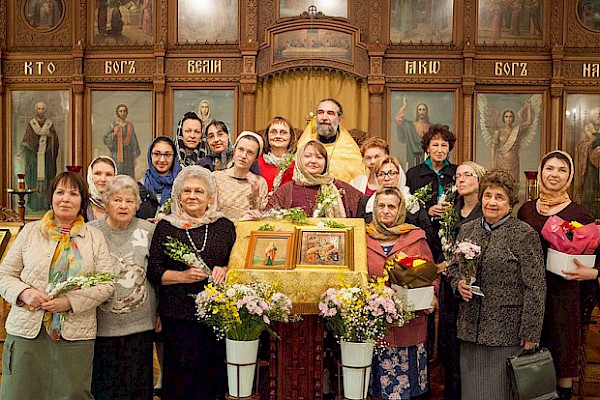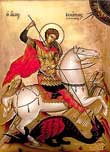St.George Russian Orthodox Church
The feast of St. Mary Magdalene 2016

On August 4, Orthodox Christians celebrate the Day of Remembrance of the Holy Myrrh-bearer Mary Magdalene, Equal-to-the-Apostles, who, according to the scriptures, "stood on Calvary at the Cross, empathizing with the sufferings of the Redeemer and sharing the sorrow of the Mother of God."
WHO WAS ST. MARY MAGDALENE?
St. Mary Magdalene, called by the Orthodox Church both Myrrh-bearer and Equal-to-the-Apostle, is commemorated on July 22/August 4, as well as with the other Myrrh-bearers on the second Sunday after Easter. Born in the seaport town of Magdala on the Sea of Galilee, she played an important role during Christ’s ministry, crucifixion, and resurrection.
The Gospels provide the little that we know about St. Mary Magdalene, from whom Christ cast out seven demons. St. Mary and other wealthy women followed Christ and “provided for them out of their means” (Luke 8.1-3). According to the Gospel accounts (Matthew 27:55056; Mark 15.40; Luke 23.49; John 19.25), she and other women followers were present at the crucifixion. They watched where Christ was laid, and maid plans to come to the tomb on the following day to perform the ritual for anointing the dead and preparing the body for burial.
In the Gospels of Matthew and Luke, St. Mary and the women with her are instructed by the angel at the tomb to go and proclaim the good news of the resurrection to the male disciples. St. Mark, in his Gospel, recounts that St. Mark, in his Gospel, recounts that St. Mary was the first to see and speak with the risen Christ. In the Gospel of John, Jesus Himself tells her to go to the apostles with the gospel; (thus, many call her the “Apostle to the Apostles”). Her meeting with the risen Christ outside His tomb is one of the most touching scenes in the Gospel of St. John:
Jesus said to her, “Woman, why are you weeping? Whom do you seek?” Supposing Him to be the gardener, she said to Him, “Sir, if you have carried Him away, tell me where you have laid Him, and I will take Him away.” Jesus said to her, “Mary.” She turned and said to him in Hebrew, “Rabboni!” (which means Teacher). (John 20.15-16)
St. Gregory the Dialogist (Pope Gregory the Great) is believed to have begun the tradition in the Western Church, not accepted in the Eastern Church, which identified St. Mary with the “sinful woman” in the seventh chapter of Luke. There are two possible reasons for this misidentification: (1) St. Mary was from Magdala, a port city that had a reputation for unsavory goings-on, and the reputation of the city may have been transferred to St. Mary; or (2) St. Mary is first mentioned in the Gospel of Luke directly following the account of the sinful woman (Luke 7.36-50) and so was associated with her. Further parallels can be drawn from the fact that the sinful woman is sometimes called a myrrh-bearer, because she anointed Christ’s feet with ointment and wiped them with her hair. St. Gregory also supposed that Mary of Bethany was the same person as St. Mary Magdalene.
The Orthodox Church also rejects a number of legends concerning the life of St. Mary that mainly originate from the Western medieval cult of the saints. One legend suggests that she was in love with St. John the Theologian and became a prostitute when he rejected her to follow Jesus (this may have developed from the earlier misidentification of Mary with the sinful woman or from Mary’s later work with John in Ephesus). Another legend asserts that St. Mary Magdalene (thought to be Mary of Bethany) traveled with her sister Martha and her brother Lazarus to evangelize the inhabitants of Provence, and area of modern-day southern France. In the Middle Ages, at least three Provençal monasteries claimed to have her body.
For the Orthodox Church, little more is known of her life beyond the Gospel accounts. After Christ’s ascension, she is believed to have gone to Ephesus and evangelized with St. John the Theologian. There she died and was buried near the entrance to the tomb of the Seven Sleeping Youths. During the reign of the Emperor Leo (which one is uncertain), her relics were transferred to the monastery of St. Lazarus, where an annual synaxis was celebrated for her.
By the Gospel accounts, we come to know the reality of St. Mary Magdalene’s love for Christ and her fidelity to Him during His passion, death, and resurrection. The Church has recognized her as a disciple and Equal-to-the-Apostles, and we ask for her continuing intercessions for us.
St. Mary Magdalene Orthodox Church,
Fenton Michigan
SOURCE: www.orthochristian.com
